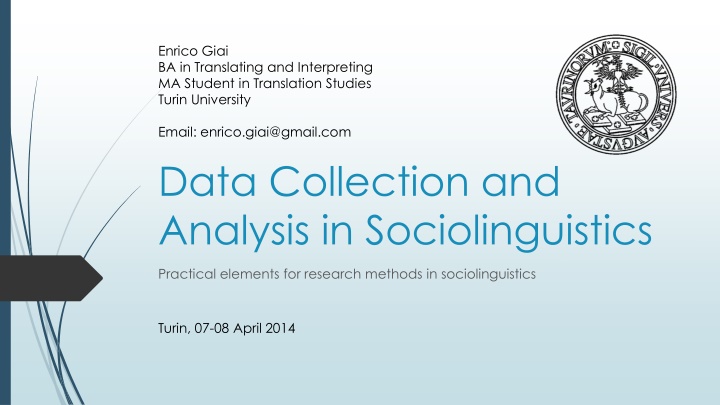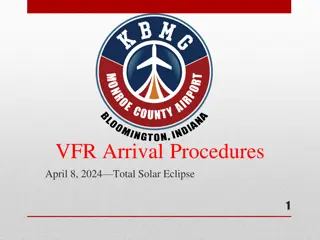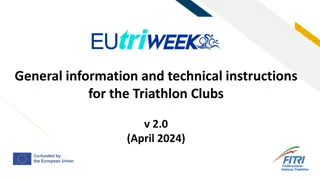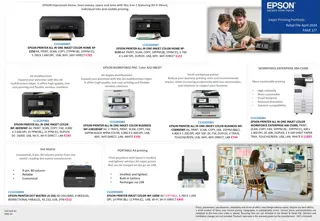
Practical Elements for Research Methods in Sociolinguistics
Explore practical aspects of data collection, analysis, and inferential statistics in sociolinguistics with Enrico Giai, a BA student in Translating and Interpreting at Turin University. Learn about variables, hypothesis testing, experimental and null hypotheses, statistical significance, and the Chi-Square test. Enhance your knowledge in sociolinguistics research methods through this comprehensive content.
Download Presentation

Please find below an Image/Link to download the presentation.
The content on the website is provided AS IS for your information and personal use only. It may not be sold, licensed, or shared on other websites without obtaining consent from the author. If you encounter any issues during the download, it is possible that the publisher has removed the file from their server.
You are allowed to download the files provided on this website for personal or commercial use, subject to the condition that they are used lawfully. All files are the property of their respective owners.
The content on the website is provided AS IS for your information and personal use only. It may not be sold, licensed, or shared on other websites without obtaining consent from the author.
E N D
Presentation Transcript
Enrico Giai BA in Translating and Interpreting MA Student in Translation Studies Turin University Email: enrico.giai@gmail.com Data Collection and Analysis in Sociolinguistics Practical elements for research methods in sociolinguistics Turin, 07-08 April 2014
Tuesday, April 8th Main topics 2 Inferential statistics Variables Hypothesis Null Hypothesis Likelihood Chi square test ANOVA Rbrul for inferential and multivariate statistics
Inferential Statistics Variables 3 Two types of variables Dependent Independent The independent variable(s) affect the dependent variable in some predictable way Another classification (for questions): Category type variables (usually dependent variables) Ordinal type variables Continuous type variables (usually independent variables)
Inferential Statistics Experimental and Null Hypothesis 4 Experimental hypothesis The hypothesis according to which a certain variable is affected in a predictable & systematic way by some other variable Must be tested Null hypothesis: the exact opposite of the experimental hypothesis
Inferential Statistics Likelihood and Statistical Significance 5 Likelihood, or statistical significance The probability for the null hypothesis to be true Expressed by a percentage As a convention in the humanities and social sciences, we take 5% sure that the null hypothesis is true (p = 0.05) as a cut-off point. Greater than 5% sure (p > 0.05), we cannot reject the null hypothesis; less than or equal to 5% sure (p 0.05), we reject the null hypothesis (Levon 2010:71)
Inferential Statistics Chi Square Test (1) 6 Related to 2 category type questions The test compares the observed frequencies with the expected ones, in order to establish whether the null hypothesis is true or false How to Calculate the observed frequencies Calculate the expected frequencies Calculate the chi squared values Sum the chi squared values up Calculate the degree of freedom If the critical value of significance is higher than the one related to p=0.05, the null hypotesis will be true You can use RBRUL or TEST.CHI.QUAD Excel formula
Inferential Statistics Chi Square Test (2) 7 You can use TEST.CHI.QUAD Excel formula Example: occurrences of code-switching in relation to age brackets in Filipino language survey N.B.: Age as a category type question because we consider age brackets!
Inferential Statistics Chi Square Test (3) 8 Observed frequencies: =(E3*B5)/E5 in H3 =(E3*C5)/E5 in I3 =(E3*D5)/E5 in J3
Inferential Statistics Chi Square Test (4) 9 Chi Square Test in J5: =TEST.CHI.QUAD(B3:D3;H3:J3) The value is > 0.05, therefore the results were achieved by chance (NO STATISTICAL SIGNIFICANCE)
Inferential Statistics Scatterplot 10 Related to 2 continuous type questions Compares the correlation between two variables Positive correlation Negative correlation You can use RBRUL see slide #56
Inferential Statistics ANOVA 11 ANalysis Of VAriance Bi/Multivariate Regression Analysis Related to more than one category type question and more than one continuous type question You can use RBRUL see e-book
Inferential and multivariate statistics 12 Inferential statistics Formulating and testing hypothesis Key concepts: likelihood, dependent and independent variables, hypothesis and null hypothesis Multivariate statistics, or statistical modelling How a dependant variable changes in relation to two or more independent variables Key concept: the three lines of evidence (See Tagliamonte 2012) Statistical significance (p<0.05) Factor weight (FW 1) Strength of factor group
Rbrul and multivariate statistics 13 Rbrul Based on R Tool for multivariate statistics Input: Excel worksheet Output: numbers What for? Formulating hypothesis after descriptive analysis of a questionnaire/corpus Testing hypothesis with inferential multivariate analysis What do we need? Excel worksheet in .csv format R
Converting .xlsx format to .csv (1) Let s consider the Filipino language survey (.xls format) 1. Go to http://www.docspal.com (or another online converter) 14
Converting .xlsx format to .csv (2) 2. Upload .xls or .xlsx Excel file and select .csv in convert to 15
Converting .xlsx format to .csv (3) 3. Click on Convert 16
Converting .xlsx format to .csv (4) 4. Click on output file 17
Converting .xlsx format to .csv (5) 5. Click on Salva pagina con nome 18
Converting .xlsx format to .csv (6) 6. .csv output file 19
Rbrul: Installation step-by-step (1) 1. Download R: http://cran.r-project.org/bin/windows/base/ 20
Rbrul: Installation step-by-step (2) 2. Press Avanti until the installation process finishes. 21
Rbrul: Installation step-by-step (3) 3. Open R. If you have troubles, right-click Esegui come amministratore . 22
Rbrul: Installation step-by-step (4) 4. Open R. 23
Rbrul: Installation step-by-step (5) 5. Write: source( http://www.danielezrajohnson.com/Rbrul.R ) 24
Rbrul: Installation step-by-step (6) 6. Hit the Enter key 25
Rbrul: Installation step-by-step (7) 7. Write rbrul() 26
Rbrul: Installation step-by-step (8) 27 8. Hit the Enter key. Now you are in Rbrul.
Rbrul: Loading data (1) 28 1. Write 1 and press the Enter key
Rbrul: Loading data (2) 29 2. Write c and press the Enter key
Rbrul: Loading data (3) 30 3. Open the questionnaire in .csv
Rbrul: Loading data (4) 4. Now you are ready 31
Example: Linguistic survey and RBRUL (1) 32 Considered variables: Code-switching (category type variable/question) Who speaks what language(s) at work, with friends, & with family in IT & PH (continuous type question) Who uses what language(s) when watching TV, reading, dreaming, & thinking (category type question) Number of known languages (continuous type question) Age (continuous type question)
Example: Linguistic survey and RBRUL (2) 33 Hypothesis: Code-switching & who speaks what language(s) at work, with friends, & with family in IT & PH (cat+con: bivariate analysis) Code-switching & Who uses what language(s) when watching TV, reading, dreaming, & thinking (cat+cat: cross tabulation) Number of known languages & age (con+con: scatterplot)
Hypothesis: Code-switching and language use (1) 34 Formulate hypothesis on code-switching and language use with friends in IT/PH using bivariate analysis. Is there a relation between the number of languages used to talk with friends in PH and in IT & the occurrences of code-switching? Average PH: 1.43 Average IT: 1.31 Category+continuous: bivariate analysis 1. Press 5 for bivariate analysis and hit Enter key.
Hypothesis: Code-switching and language use (2) 35 Formulate hypothesis on code-switching and language use with friends in IT/PH using bivariate analysis 2. Choose variables (1)
Hypothesis: Code-switching and language use (3) 36 Formulate hypothesis on code-switching and language use with friends in IT/PH using bivariate analysis 3. Dependant variable (50)
Hypothesis: Code-switching and language use (4) 37 Formulate hypothesis on code-switching and language use with friends in IT/PH using bivariate analysis 4. Type of response (Enter)
Hypothesis: Code-switching and language use (5) 38 Formulate hypothesis on code-switching and language use with friends in IT/PH using bivariate analysis 5. Choose application (2 + Enter x3)
Hypothesis: Code-switching and language use (6) 39 Formulate hypothesis on code-switching and language use with friends in IT/PH using bivariate analysis 6. Choose independent variable (# lang used with Friends in IT/PH) (42 Enter 46 Enter x2)
Hypothesis: Code-switching and language use (7) 40 Formulate hypothesis on code-switching and language use with friends in IT/PH using bivariate analysis 7. Choose continuous variable (42 Enter 46 Enter x2)
Hypothesis: Code-switching and language use (8) 41 Formulate hypothesis on code-switching and language use with friends in IT/PH using bivariate analysis 8. Modelling (5 Enter)
Hypothesis: Code-switching and language use (9) 42 Formulate hypothesis on code-switching and language use with friends in IT/PH using bivariate analysis 8. Modelling (5 Enter)
Hypothesis: Code-switching and language use (10) 43 Formulate hypothesis on code-switching and language use with friends in IT/PH using bivariate analysis Logodd: 0.571 vs 0.292 (If positive, high likelihood) Deviance: 142.818 vs 144.821 (The larger the deviance, the less accurate the result given) P value: 0.0644 vs 0.234 (>0.05) Therefore: Correlation code-switching/language use with friends is NOT SIGNIFICANT
Hypothesis: Code-switching and language use (11) 44 The same procedure can be adopted in analysing the relation between code-switching & language used with family & at work in Italy and in the Philippines
Hypothesis: Code-switching and language use TV (1) 45 Formulate hypothesis on code-switching and language use when watching TV using cross tabulation and Chi Square Test. Is there a relation between the languages used to watch TV & the occurrences of code-switching? Category+category: cross tabulation 1. Press 4 for cross tabulation and hit Enter key.
Hypothesis: Code-switching and language use TV (2) 46 Formulate hypothesis on code-switching and language use when watching TV using cross tabulation and Chi Square Test. 2. Choose factors for columns (50 Enter)
Hypothesis: Code-switching and language use TV (3) 47 Formulate hypothesis on code-switching and language use when watching TV using cross tabulation and Chi Square Test. 3. Choose factors for rows (51 Enter x3)
Hypothesis: Code-switching and language use TV (4) 48 Formulate hypothesis on code-switching and language use when watching TV using cross tabulation and Chi Square Test. 4. Cross tabulation Do those who watch TV in Italian code-switch more?
Hypothesis: Code-switching and language use TV (5) 49 Formulate hypothesis on code-switching and language use when watching TV using cross tabulation and Chi Square Test. 5. Chi Square Test in Excel Effective frequency of Italian/Code-switching: 45 Expected frequency of Italian/Code-switching: 32.09 Multiply the total amount of observed frequencies related to the first independent variable (=45) and the total amount of observed frequencies related to its dependent variable (=87). The amount is then divided by the total amount of the frequencies (=122). ???.????.=87 45 = ??.?? 122
Hypothesis: Code-switching and language use TV (6) 50 Formulate hypothesis on code-switching and language use when watching TV using cross tabulation and Chi Square Test. 5. Chi Square Test in Excel






















